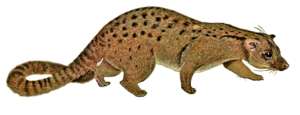African palm civet facts for kids
Quick facts for kids African palm civet |
|
|---|---|
 |
|
| Conservation status | |
| Scientific classification | |
| Genus: |
Nandinia
|
| Species: |
binotata
|
 |
|
| African palm civet range | |
| Synonyms | |
|
Viverra binotata Gray 1830 |
|
The African palm civet (Nandinia binotata), also called the two-spotted palm civet, is a small mammal. It belongs to a group of animals called Feliformia, which includes cats and other cat-like creatures.
This animal has short legs and small ears. Its body looks a bit like a civet cat, and it has a long, flexible tail that is about as long as its body. Adult African palm civets usually weigh between 1.7 and 2.1 kilograms (about 3.7 to 4.6 pounds).
These civets live in the forests of eastern Africa and the Congo River basin. They mostly live in trees. African palm civets are omnivores, meaning they eat both plants and animals. They are also generally solitary (they live alone) and nocturnal (they are active at night).
Contents
Discover the African Palm Civet
The African palm civet is a fascinating animal found in the forests of Africa. It's known for its unique looks and habits. Even though it's called a "civet," it's actually quite special and different from other civets.
What Does an African Palm Civet Look Like?
The African palm civet is a small, slender animal. It has soft, thick fur that is usually brownish-gray. You might notice two spots on its back, which is why it's sometimes called the "two-spotted palm civet."
Its tail is long and can be used for balance when climbing trees. Their eyes are large, which helps them see well in the dark. They also have small, rounded ears.
Where Do African Palm Civets Live?
African palm civets are native to the forests of Africa. You can find them in the eastern parts of the continent and in the large area around the Congo River. They prefer places with lots of trees, like rainforests.
These animals are very good at climbing. They spend most of their lives up in the trees. This helps them find food and stay safe from predators on the ground.
What Do African Palm Civets Eat?
The African palm civet is an omnivorous animal. This means their diet includes a wide variety of foods. They eat both plants and other animals.
Their meals can include:
- Small rodents
- Insects
- Eggs
- Carrion (dead animals)
- Various kinds of fruit
- Birds
- Fruit bats
This varied diet helps them survive in different forest environments.
How Do African Palm Civets Behave?
African palm civets are mostly nocturnal. This means they are most active during the night. They use the darkness to hunt for food and move around safely.
They are also generally solitary animals. This means they prefer to live alone rather than in groups. They usually only come together to mate.
A Special Family Tree
Even though the African palm civet looks like other civet species, it's actually quite unique. Scientists have found that it's genetically different from other civets. This means its family tree separated from other civets a very long time ago, even before cats evolved.
Because of these differences, the African palm civet is the only species in its own special group, called the genus Nandinia. It's also placed in its own unique family, called Nandiniidae. Not all scientists agree on this classification, but it shows how special this animal is!
See also
In Spanish: Civeta africana de las palmeras para niños


